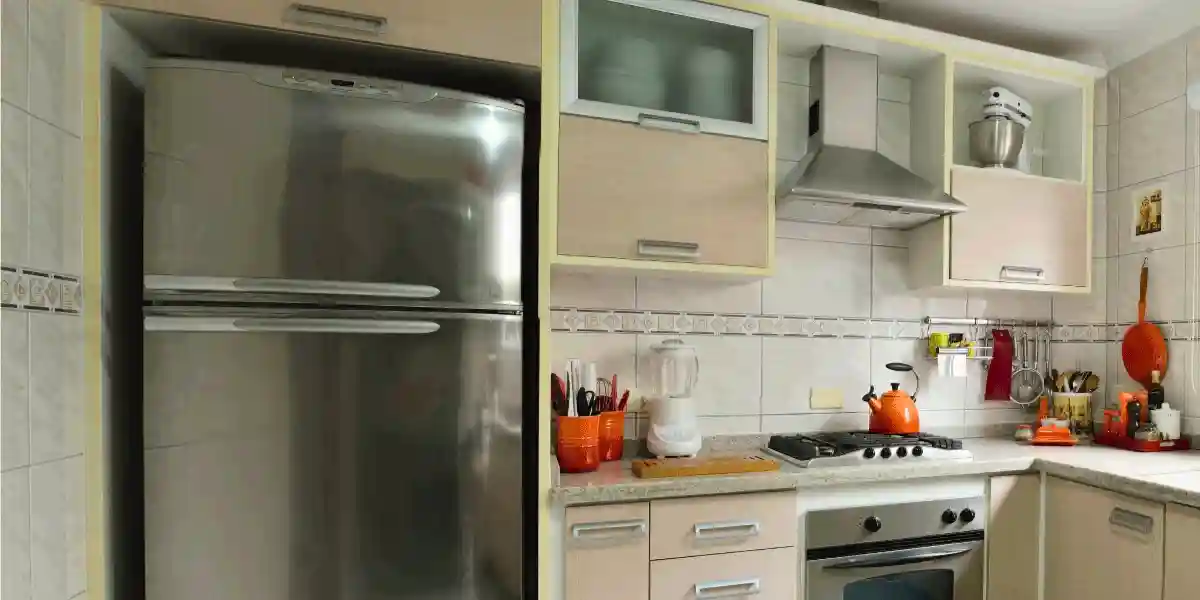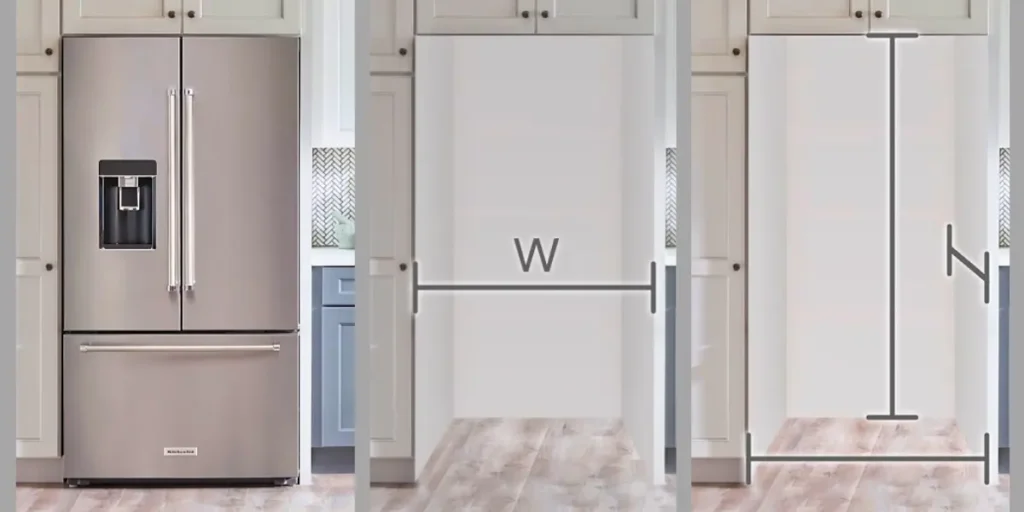
Are you optimizing every inch of your kitchen space? When it comes to arranging appliances like refrigerators, the ideal positioning can make a significant difference. Wondering about the perfect distance between your refrigerator and the side wall?
This simple adjustment could impact both functionality and aesthetics. Dive in to explore the often overlooked but crucial considerations for an efficiently organized kitchen.
How much Space is between Refrigerator and Side Wall?
When it comes to the space between a refrigerator and a side wall, it is important to provide adequate clearance for enhanced performance, safety, and efficiency.
The recommended distance may vary slightly depending on the source, but here are the general guidelines:
- The recommended minimum distance between a refrigerator and the side wall is 2 inches on either side
- It is also advisable to leave an additional 1/8 inch of space on either side of the fridge for proper air circulation
- Some sources suggest leaving 1 to 2 inches of space between the sides of the refrigerator and the wall
- Another recommendation is to allow for an ½ inch to 1 inch of extra space between the appliance and nearby side walls
- For double-door fridges, you may need about 5 inches of additional space on either side so both doors can open fully without hitting anything
Recommended space between refrigerator and side wall based on various well-renowned resource sites:
- Home Decor Bliss: 1 to 2 inches on each side of the refrigerator.
- Mr. Appliance: Side Clearance is planned for between 1/2 inch to 1 inch of clearance on both sides of the unit. Rear Clearance is Allowed between 1 to 2 inches of space at the rear of the refrigerator.
- Canadian Home Style: A minimum of 2 inches on either side of the refrigerator.
- MyChesCo: 2 inches from the back wall, 1 inch from the upper cabinets, and 1/8 inch on either side of the refrigerator.
- Ask MetaFilter: 1/2 inch (1.25 cm) on each side and at the top for proper ventilation.
- Reddit: less than 1 inch between the counter and the fridge.
Distance Based on Refrigerator Size

Small Refrigerators
- Tiny Homes or Dorms: In small spaces, every inch counts. A 1-inch gap might be best.
- Standard Homes: In regular homes, a 2-inch space works well. It balances airflow and space-saving.
Medium Refrigerators
- Freezer Position: Top-freezer models might need 3 inches. Bottom-freezer models can use 2 inches.
- With External Condensers: Models with these parts need more space. 3 inches are good.
Large Refrigerators
- Side-by-Side Doors: These might need 4 to 5 inches. Extra space helps both doors open.
- French door Models: A 3-inch gap usually works here. It’s good for cooling and door movement.
Space for Doors and Handles
Door Opening towards the Wall
- Thicker Doors: With bulky doors, use 4 inches. They need more room to swing.
- Thinner Doors: These might need just 2 inches. It lets them open without hitting the wall.
Handles Sticking Out
- Curved Handles: These might need more room. Add 2 inches to the normal space.
- Flat Handles: These are slimmer. 1 extra inch is usually enough.
Space for Ventilation
Top Ventilation
- Low Ceilings: If the ceiling is low, use 2 inches. More space helps hot air escape.
- High Ceilings: A 1-inch gap is good here. Air can move up and away easily.
Back Ventilation
- Dusty Area: In dusty places, add an inch. More room lets dust fall away from the fridge.
- Clean Areas: In these spots, normal space is fine. Follow the size guide.
Space Based on the Wall Material

Brick or Concrete Walls
- Rough Surface: If the wall is rough, add an inch. It keeps the fridge from scraping.
- Smooth Surface: Normal spacing is good here. Just follow the size rules.
Wood or Drywall
- Textured Paint: If the paint is bumpy, add an inch. It protects the wall and fridge.
- Flat Paint: Here, normal spacing rules work well.
Special Considerations
Water and Ice Dispensers
- Flexible Water Lines: These need more space. Follow the fridge manual closely.
- Rigid Water Lines: These need precise spacing. Add an inch for safety.
Wheelbase for Moving
- Thick Wheels: These might need more room. Add 2 inches to move the fridge easily.
- Slim Wheels: These can use normal space. 1 extra inch is usually enough.
Custom Solutions for Small Kitchen Spaces

If you have a small kitchen space and are wondering how much space you should leave between your refrigerator and the side wall, there are several custom solutions you can consider. Here are some ideas:
Use a counter-depth refrigerator
Counter-depth refrigerators are designed to be shallower than standard models, which means they take up less space and can fit more easily into tight spots.
Install a sliding shelf
If you have a narrow gap between the fridge and the wall, you can install a sliding shelf that can be pulled out when you need to access items at the back of the fridge.
Use a mini-fridge
If you don’t need a full-size refrigerator, you can opt for a mini-fridge that takes up less space and can be placed in a corner or under a counter.
Consider a built-in fridge
Built-in refrigerators are designed to fit seamlessly into your kitchen cabinetry, which can save space and create a streamlined look.
Use a fridge with reversible doors
Some refrigerators come with reversible doors that can be adjusted to open from either side, which can be helpful if you have limited space on one side of the fridge.
Use a pull-out pantry
If you have a narrow space between the fridge and the wall, you can install a pull-out pantry that can be easily accessed when needed.
Install a rolling cart
A rolling cart can be a great solution for storing items that you need to access frequently, such as spices or cooking utensils. You can easily move the cart out of the way when you need to access the fridge.
Use a tension rod
A tension rod can be installed between the fridge and the wall to create hanging space for kitchen towels, pot holders, or other small items.
Install a magnetic knife holder
A magnetic knife holder can be mounted on the side of the fridge to save counter space and keep your knives within easy reach.
Use a wall-mounted organizer
A wall-mounted organizer can be a great solution for storing small items like spices, utensils, or cleaning supplies. You can mount it on the wall next to the fridge for easy access.
Making Room for the Refrigerator
- Move Cabinets If Needed: If there’s not enough space, you may have to move cabinets. This might need a grown-up to help.
- Consider the Door Swing: Think about the way the fridge door opens. Make sure it won’t hit the wall or anything else.
- Use Spacers If Needed: Sometimes you can use spacers to keep the right distance from the wall. You can find them at hardware stores.
Special Solutions for Small Kitchens
- Think Vertical: Sometimes using tall, skinny fridges can save space. They still need room to breathe, though.
- Consider a Mini Fridge: If the kitchen is really small, a mini fridge might be best. Measure it the same way as a big one.
- Use a Professional: If you’re stuck, a kitchen expert can help. They know all about fitting fridges in small spaces.
What Were Some Clever Methods Used to Keep Food Cold Before Refrigerators?
Before the invention of refrigerators, people relied on clever pre-refrigerator food preservation methods to keep food cold and fresh. One method involved using icehouses, where large chunks of ice were stored underground or in insulated structures. Another method was the use of natural cooling techniques, such as placing perishables in cool cellars or in running water streams. Additionally, people often used evaporative cooling by surrounding food with wet cloth or keeping it in clay pots, taking advantage of the principle that evaporation cools the surroundings. These innovative techniques helped civilizations maintain food quality for extended periods, offering practical solutions in the absence of modern refrigeration.
Consequences of Not Leaving Enough Space between the Refrigerator and the Side Wall
Overheating
Refrigerators generate heat as they operate, and proper airflow is crucial for dissipating this heat. When a refrigerator is placed too close to the side wall, it restricts the airflow around the unit.
This can lead to inadequate cooling and cause the refrigerator’s components, such as the compressor and condenser, to overheat.
Overheating can result in decreased efficiency, increased energy consumption, and potential damage to the internal components of the refrigerator.
Reduced Efficiency and Increased Energy Consumption
When a refrigerator doesn’t have enough space around it, the restricted airflow can impair its cooling efficiency. The unit may struggle to maintain the desired temperature, leading to longer running times and increased energy consumption.
This can result in higher energy bills and unnecessary strain on the refrigerator’s components, potentially shortening its lifespan.
Compressor Failure
The compressor is a vital component of a refrigerator that helps circulate refrigerant and maintain the desired temperature. When a refrigerator lacks sufficient space for proper ventilation, the compressor can become overworked and overheat.
Over time, this can lead to compressor failure, which is a costly repair and may require replacing the entire refrigerator.
Condensation and Moisture Buildup
Inadequate airflow around the refrigerator can contribute to condensation and moisture buildup. This can occur on the exterior surfaces of the refrigerator, leading to potential water damage, discoloration, and even mold growth.
Moisture buildup can also affect the refrigerator’s insulation and cause it to deteriorate over time.
Difficulties in Cleaning and Maintenance
Insufficient space between the refrigerator and the side wall can make it challenging to clean the unit and perform routine maintenance tasks.
It may be difficult to access the back of the refrigerator for dusting or vacuuming the coils, which can further impact its efficiency and performance.
Blocking Airflow
Why does Air need to Move? The fridge has coils. Coils remove heat. They need air to work. Without space, air doesn’t move well. The fridge works harder. The heat stays in. This leads to problems.
Shortened Lifespan
A Tired Fridge Breaks Sooner. Working too hard wears the fridge out. Parts inside might break. This means you need a new fridge sooner. It’s costly and troublesome.
Spoiling Food
Not Just Wasting Food. Food in a warm fridge goes bad. You throw it away. You lose money. Bad food can make people sick. This can be serious.
FAQs
Can I place my refrigerator flush against the side wall?
It’s best to leave a small gap of at least 2 inches for optimal airflow.
Is the space requirement the same for all refrigerators?
Most refrigerators have similar space requirements, but it’s important to check your manufacturer’s guidelines for specific recommendations.
Can I place shelves or other items next to the refrigerator?
Placing items too close can restrict airflow; maintaining the recommended space is ideal.
Final Words
You don’t want your fridge gasping for air! To maximize efficiency and longevity, leave at least 2 inches of space between your refrigerator and the side wall.
This simple trick allows for proper ventilation, easy cleaning, and saves you money on energy costs in the long run.
